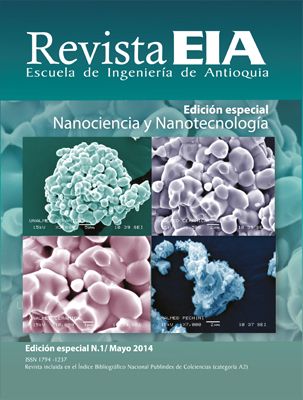One step synthesis of magnetic particles covered with casein surfactant
One step synthesis of magnetic particles covered with casein surfactant


This work is licensed under a Creative Commons Attribution-NonCommercial-NoDerivatives 4.0 International License.
Copyright statement
The authors exclusively assign to the Universidad EIA, with the power to assign to third parties, all the exploitation rights that derive from the works that are accepted for publication in the Revista EIA, as well as in any product derived from it and, in in particular, those of reproduction, distribution, public communication (including interactive making available) and transformation (including adaptation, modification and, where appropriate, translation), for all types of exploitation (by way of example and not limitation : in paper, electronic, online, computer or audiovisual format, as well as in any other format, even for promotional or advertising purposes and / or for the production of derivative products), for a worldwide territorial scope and for the entire duration of the rights provided for in the current published text of the Intellectual Property Law. This assignment will be made by the authors without the right to any type of remuneration or compensation.
Consequently, the author may not publish or disseminate the works that are selected for publication in the Revista EIA, neither totally nor partially, nor authorize their publication to third parties, without the prior express authorization, requested and granted in writing, from the Univeridad EIA.
Show authors biography
The one-step coprecipitation method is used to obtain magnetic nanoparticles controlling the pH (10 and 12), and casein surfactant (CS) concentrations (1 % and 3 % (m/m)). CS has not been used so far for stabilizing magnetic iron oxide ferrofluids. The magnetic nanoparticles have a magnetite core with maghemite in surface, and a shell of polymer. The transmission electron images confirm the crystallinity, particle size distribution in the range of 5-10 nm, and the spinel structure of the nanoparticles. Mössbauer results at 80 K showed line shapes dominated by magnetic relaxation effects with sextets and combinations of sextets and doublets. The interactions of the surfactant with the nanoparticle surface are strong showing at least two surfactant layers. The magnetic behavior was evaluated by moment versus temperature and magnetic field measurements. The nanoparticles showed superparamagnetic behavior at room temperature and blocked (irreversible) behavior at 5 K. The saturation magnetization presented lower values than reported bulk systems due to the presence of a large layer of maghemite. The FC/ZFC magnetization vs. temperature curves confirmed the superparamagnetic nature of the iron oxide particles and the strong interactions for pH 12 samples and weak interactions for pH 10 samples. The particle growth was dominated by the surface properties of the nanoparticles.
Resumen: Se usa el método de coprecipitación para obtener nanopartículas magnéticas controlando el pH (10 y 12) y la concentración del caseinato de sodio (CS) (1 % y 3 %(m/m)). CS no se ha utilizado hasta el momento para estabilizar ferrofluidos magnéticos. Las partículas muestran un núcleo de magnetita, una capa de maghemita sobre el mismo, y otra capa exterior de la proteína. La microscopía electrónica de transmisión muestra partículas cristalinas, una distribu- ción de tamaños entre 5-10 nm, y la estructura de espinela. Los resultados Mössbauer a 80 K muestran formas de línea dominadas por efectos de relajación magnética. La interacción de la proteína con la superficie de las nanopartículas es fuerte y muestra varias capas de proteína. El comportamiento magnético se evaluó mediante medidas termomagnéticas y de momento versus campo magnético. Estas revelaron un sistema superparamagnético a 300 K y bloqueado a 5 K. La magnetización de saturación mostró valores menores que en el volumen posiblemete debido a la presencia de la maghemita. Las medidas termomagnéticas confirmaron el superparamagnetismo y mostraron que las muestras obtenidas a pH 12 presentan interacciones fuertes mientras que las de pH 10 muestran interacciones débiles. El crecimiento de las partículas fue dominado por las propiedades superficiales de las partículas.
Article visits 229 | PDF visits 136
